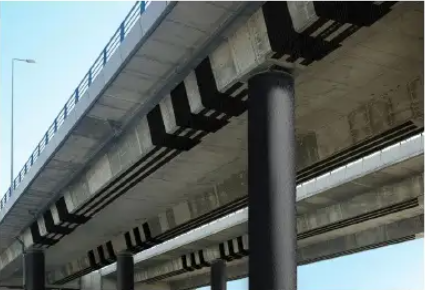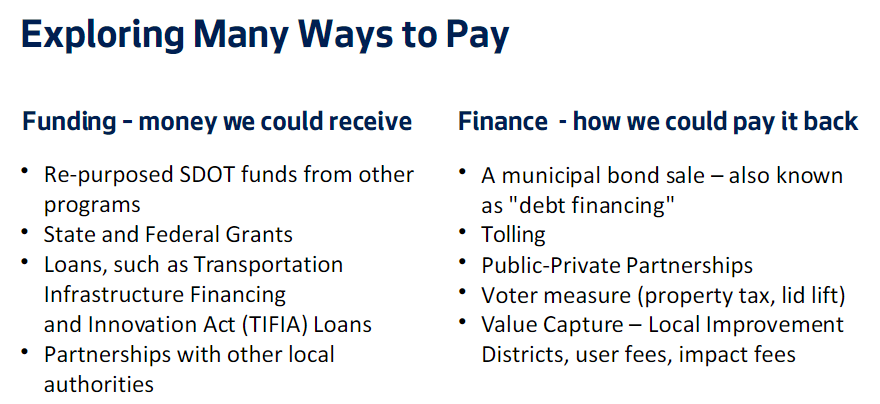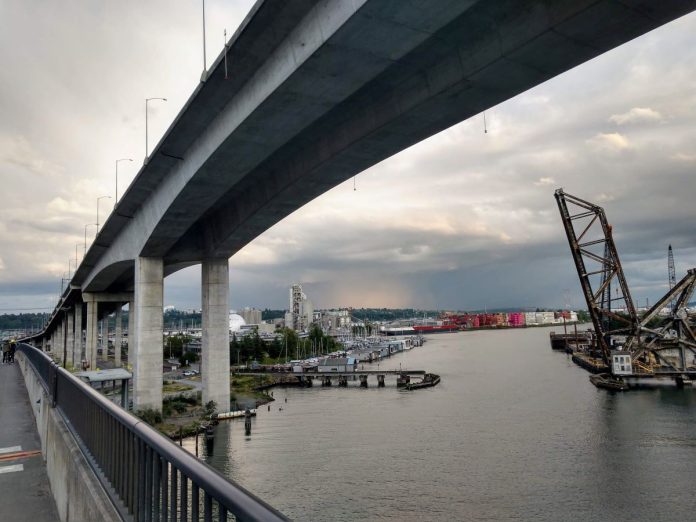Four months into the West Seattle Bridge closure, we do have some answers but plenty of lingering questions, too. The Seattle Department of Transportation (SDOT) has made progress on temporarily shoring up the bridge and has embarked on stakeholder engagement for mitigation and options for repair or replacement. Multiple task forces have been launched.
Among them, the West Seattle Interagency Task Force prepared an emergency response plan in early May. Scenarios of immediate evacuation, one to five day notice evacuation, and controlled demolition have been planned. These plans would be put into motion based on how and if conditions of the bridge reach critical thresholds.
To track the status of the West Seattle Bridge, SDOT completed the installation of a monitoring system in mid-May. Motion sensors, crack monitors, and cameras will afford SDOT real-time information on the progression of the cracking, and bridge reaction to environmental changes and repair measures. Ultimately, the system will guide SDOT on the technical feasibility of repair or replacement.
SDOT has also installed an installation monitoring system and non-destructive testing on the Low Bridge, which parallels the “High-Rise” bridge via Spokane Street. While the natural cracking on the Low Bridge isn’t of imminent risk, repair work has been fast tracked just in case–this secondary bridge has taken on new importance and strain without the main artery carrying its traffic load. Proactive maintenance and repairs have also been done, and carbon fiber wrapping is being planned for the coming years.
Ongoing is stabilization work on the West Seattle High-Rise Bridge. Started in late June, hole drilling and then work platform installation will continue through late July. Then, initial carbon fiber wrapping will likely begin in late July. This initial wrapping will take around 10 weeks, a week or two of initial post-tensioning strand installation will follow. After that, engineers will release Pier 18, which is sunken and suspected as a primary source of the rapid cracking, and wrapping and post-tensioning installation will continue to shore up the bridge.

Example of a carbon fiber reinforced polymers supported bridge. (Courtesy of Seattle Department of Transportation.)
Stabilization work is necessary for work on either repairing or demolishing the West Seattle Bridge. That being said, in the West Seattle Bridge Community Task Force’s (CTF) June 24th meeting, Matthew Donahue of the Technical Advisory Board (TAB) reiterated that in all of TAB and SDOT’s investigative work so far they found that the bridge could be repaired–although it’s unclear how much it would cost.
Two New Panels
The two aforementioned panels are new additions to the West Seattle Bridge project, since we last covered the topic. Both panels were formed by SDOT.
The Technical Advisory Panel is consisted of independent experts in currently relevant fields, note that a transportation planner is absence from the panel’s current membership. They provide input and guidance on key decisions and documents. The TAP is currently working on a cost-benefit analysis with SDOT and are still collecting information to evaluate the tradeoffs between repair and replacement.

The West Seattle Bridge Community Task Force (CTF) is a collection of local business and community leaders, and activists. They aim to provide transparency, clear communication, and community engagement. Topically, the panel advises on financial and bridge decisions, traffic mitigation, project prioritization, and community interests.
Recently, the CTF engaged and agreed with SDOT immediately opening the Low Bridge to all vehicles, from 9pm to 5am. Low Bridge access was also expanded to public and private school buses on the 24th of June. Additional advice was given on other classes of users that could gain more Low Bridge access.
The two panels cross paths whenever the TAB hits a milestone and presents their evaluation on one of the CTF’s weekly meetings.
Mitigating West Seattle Transportation
To accommodate the changes in West Seattle traffic flow, SDOT is continuing to improve on the ground conditions in West Seattle. Detour routes have disproportionately increased car travel through the southeast side of West Seattle, namely Delridge and South Park.
The detours have highlighted an undeserved nature of the transportation environment in West Seattle. The most affected neighborhoods already face higher rates of air pollution, asthma, and congestion. Increased traffic threatens to deepen those issues.
In recent Seattle Transportation Benefit District (STBD) talks, the Mayor’s Office and some Councilmembers placed emphasis on increasing bus ridership in West Seattle. Transportation improvements continue in West Seattle, with the RapidRide H Line conversion project, but current resources won’t be enough to mitigate the impact on West Seattle.
“To address the fact that no number of detours will be able to handle the current number of cars seeking to get off the peninsula, SDOT’s goals are to increase West Seattle bus commuters from 17% to 30%,” said Councilmember Lisa Herbold (West Seattle/South Park) in a press release.
Councilmember Alex Pedersen, who chairs the Transportation Committee, also acknowledged the need for revenue from a renewed STBD tax to boost access in and out of West Seattle.
Reconnect West Seattle
To complement weekly CTF meetings, recent efforts to engage the community have come with SDOT’s launch of Reconnect West Seattle on July 10th. This program is a framework formed to address the needs of affected transportation groups.
It’s made up for four processes, the neighborhood prioritization process, the Reconnect West Seattle Mobility Action Plan, the Bike Network Prioritization Process, and the Freight Network Prioritization Process. Each plan has a list of potential projects that can be done quickly and cost under $100,000.
Those who work and live inside West Seattle can provide guidance on these issues in the Reconnect West Seattle Survey. SDOT hopes to implement the plan in the fall.

Repair and other options
While it isn’t fair to call recent discussion on bridge repair optimistic, TAP and SDOT findings do not rule out repair as an option. It’s still very early in the conversation, SDOT is still in a discovery phase. At this point many proposal are being considered.
SDOT has also entertained the idea of replacing the ailing bridge with a shallow tunnel recently. Like the proposal to integrate light rail into a replacement bridge, the shallow tunnel option championed by Bob Ortblad includes light rail. However, it also brings the concern of much higher cost than a bridge alternative.
Transit advocates have argued before that the funds used to build an unnecessary tunnel could be better used to further expand the light rail system. That being said, the West Seattle Bridge situation is rather unique. SDOT and TAP plan on an evaluation of all possible solutions, so I’ll reserve judgement for after the cost benefit analysis is done.
Funding
In a recent blog post, SDOT outlined possible funding options. As one might expect, the cash-strapped agency stated that any repair or replace scenario would exceed Seattle’s financial means without outside funding. Especially in the current economic climate, SDOT is considering state and federal grants, and federal loans. In the most recent CTF meeting, SDOT stated that it would be unlikely that one funding option would be enough. With that in mind, SDOT is contemplating some thorny options.

Additionally, SDOT is seeking more local funding to mitigate the near-term impact of traffic flow changes with the West Seattle Bridge’s disuse. SDOT and TAP will be conducting an Investment Grade Traffic and Revenue study to a property tax, tolling, and other options.
Going forward
The West Seattle Bridge situation is still very much in its early days. Mitigation projects are underway and being planned. At the moment, no certainty exists for either repair or replace.
At The Urbanist, we’ve discussed a rebuild of the bridge with light rail integration, and even just demolition and no rebuild. No matter what SDOT decides, some kind of structure will come into being for the West Seattle light rail expansion. At this early juncture, my only preference is to see the West Seattle light rail expansion looped into the conversation. Maybe the cost-benefit analysis will support that thought, but that analysis won’t be out until the end of summer at the earliest.
With the eventual arrive of light rail, West Seattle will emerge from this crisis more connected to the wider city. Improved transit and biking options will led to a better transportation, public health, and public safety environment for the area. Perhaps, West Seattleites and Seattleites as a whole will come out of this crisis with a greater preference for public transport.
Until then, be sure to participate in community outreach to push SDOT in the direction to help you meet your short term needs. The Reconnect West Seattle survey will run through the month of July.
Shaun Kuo is a junior editor at The Urbanist and a recent graduate from the UW Tacoma Master of Arts in Community Planning. He is a urban planner at the Puget Sound Regional Council and a Seattle native that has lived in Wallingford, Northgate, and Lake Forest Park. He enjoys exploring the city by bus and foot.


